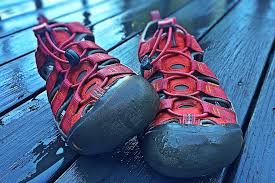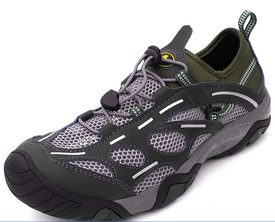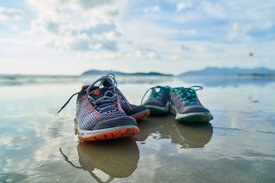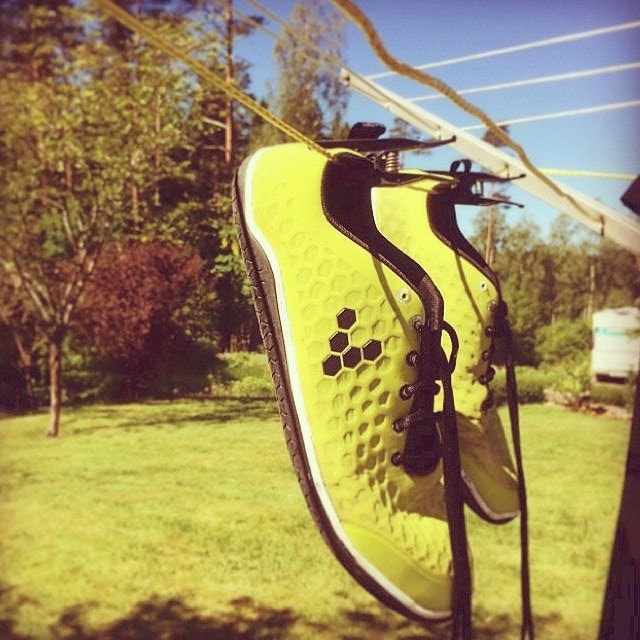If you have ever had the displeasure of sliding off a pier, then you certainly appreciate the value of water shoes. These shoes not only come in handy in giving you traction on slippery areas, but they can also help protect your feet from bacteria and viruses that lurk in wet areas. Indeed, a warm and wet environment is the perfect breeding ground for all sorts and manner of bacteria, and the harm they can cause you cannot be overlooked.
Here is all you need to know about how to choose water shoes for your water activities:
What Are Water Shoes?
Water shoes are shoes specifically made for use in wet areas. They can also be worn to activities that could potentially turn wet. They are often made of mesh material that can dry very quickly. They also have a rubber sole that is used to boost grip and traction, thus preventing slips and falls. Water shoes can be worn for any water activity ranging from swimming to surfing to kite-boarding, sailing, and even kayaking.
Types of Water Shoes
There are four major types of water shoes:
1. Open-Toe Water Shoes

As the name suggests, these shoes don’t cover the toes and are open like sandals. They often have a thick sole and come with strap laces. Slipping into them is really a piece of cake.
The shoes wrap snuggly around the heel, thus ensuring excellent protection. They also offer outstanding ventilation and breathability owing to their open design.
However, because the toes are exposed, you would be well advised not to wear these shoes to hikes and treks, especially on unknown terrains. You certainly don’t want to stub or cut your toe while hiking.
2. Closed Toe Water Shoes

These shoes are a hybrid of running shoes and sandals. They offer superb toe protection since the toes are covered. Unlike the open-toe water shoes, these shoes have a more elaborate and detailed lacing system to ensure that the shoe fits perfectly.
The shoe also comes with a padded collar to protect the ankles as well as a mesh lining to ensure quick drying.
Closed-toe water shoes are better suited for hiking and trekking as opposed to open-toe shoes because of the protection they offer your toes.
Not only do the shoes have great ventilation and drainage, but they are just as comfortable as ordinary shoes. They are great for walking in water parks, wearing to public showers, or even public pools.
3. Sports Water Shoes

These shoes are great for sporting activities carried out in the water. This could be anything from swimming to surfing to even paddle boarding.
They are created to enhance your performance while you engage in water sports. They have exceptional traction and stability.
On the whole, they are a tad heavier than your average water shoes, and this increases their durability several-fold. These shoes are ideal for swimmers, sailors, runners, hikers, and lifters.
4. Regular Water Shoes
These shoes are so-named owing to the lack of a sole and other elaborate features of an ordinary water shoe.
They are exceptionally light in weight and have outstanding drainage. They are great for walking on light terrains or for beach sports.
When to Wear Water Shoes
Water shoes can be worn to virtually every water activity imaginable. From beach sports to sailing, kayaking, to even surfing, there are no limits to when you can wear water shoes. The shoes can also be worn when you have to use a public shower, for instance, at the gym. Here, the shoes protect your feet from coming into contact with harmful bacteria or viruses. The shoes can also be worn to water parks where the pavements can get incredibly hot to protect the feet from the searing heat.
Who Should Buy Water Shoes?
If you consider yourself active in water sports, then buying a good pair of water shoes will prove to be a worthwhile investment. If your feet are also vulnerable to skin infections, especially when you use public pools or showers, then buying a pair of water shoes is a great idea.
Benefits of Wearing Water Shoes
The benefits of wearing water shoes are many and varied and include the following:
- Protection of feet from bacteria and viruses such as HPV
- Protection of feet from cuts
- Good traction in slippery surfaces preventing falls
- Improving performance in water sports
- Protecting your feet from hot surfaces
How to Choose the Best Water Shoes
When choosing water shoes, you ought to consider some important factors. These are:
Material
You want to choose a water shoe that is made of quality and durable material. For water shoes, a lightweight mesh is the best material since it can dry very fast. It is also very breathable, which leaves no room for sweating and odors. You would be well advised to steer off the leather as it gets heavy when wet. However, shoes made of synthetic material are great since they are lightweight and durable.
Fit
One cannot overemphasize just how important it is to buy shoes that fit snuggly. If the shoes are too big, they will keep slipping off, and these could cause blisters. Shoes that are too tight can cause you untold discomfort. If you are purchasing the shoes online, first read reviews to ascertain whether or not the shoes are always true to size.
Traction
Where there is water, the chances of slipping and falling are very high. This is why you should choose a water shoe that offers you a solid grip on the surface. Check the treads to ensure that they are big enough to keep you safe.
Flexibility
You also want a shoe that is not too stiff, as this can make wearing it rather uncomfortable. Choose a flexible shoe instead, and you will be glad you did!
Toe Protection
A toe guard is essential for safeguarding your safety. It ensures that your toes are protected at all times from stubs and cuts. Shoes with toe protection are great for walking, jogging, trekking or even hiking on uneven and jagged surfaces.
Comfort
You certainly want a comfy water shoe if you are to enjoy any activity when wearing it. Look for shoes with great cushioning that offers support for toes, arches, and heels.
Sole
Another factor you should keep in mind when buying water shoes is the type of sole they have. Shoes with a thick soles are not only more durable, but they also offer your feet better protection against sharp objects found on the ground.
Fast Drying
Given that water shoes are meant to be worn in water, it is essential that they dry quickly to keep odors and bacteria at bay. The best water shoes are those that are made of lightweight mesh owing to its good drainage and fast-drying properties.
Lightweight
Water shoes should be light in weight so as not to drag you down as you engage in water sports. Ideally, each water shoe should weigh less than a pound.
Aeration
You need a shoe with great aeration for 3 main reasons; it dries fast, keeps odors at bay, and prevents the growth of mold in your shoes.
What Type of Shoe for Outdoor Activities
For activities where sliding is a real danger, then you should buy shoes with good traction. Such activities include paddle boarding, boating, jet skiing, kayaking, and surfing. If your main concern is protection for your feet, then buy shoes that have closed toes and a thick synthetic sole. For Aqua aerobics, where ease of movement is essential, then look for shoes that have midfoot support and a sticky rubber sole. Cross-fit and cross-training demand shoes with a good lacing system and great drainage.
How to Wash Water Shoes
Washing water shoes is a simple four-step process. First, you need to wash the shoes with soap and clear water. You should then dry them with a hand- towel or newspaper to drain the moisture. Then let them air dry or use a blow dryer to speed up the process. Then apply gold bond powder or a deodorizing solution to keep them smelling fresh. Only wash them in the washer if the tag says so. If you do, use cold water to protect the integrity of the shoes and also use gentle liquid detergent. Never ever wash leather or suede shoes in the washer.

In Conclusion
On the whole, water shoes are a great investment for anyone. They help keep your feet safe in the water or the ground and allow you to enjoy yourself to the maximum. Follow the tips above in order to choose the best pair of water shoes so you can protect your feet while practicing your water activity.
More articles
- Boat shoes for sailing
- Boat shoes for women
- How to choose boat shoes for men
- Boat shoes for men
- What shoes to wear on a boat
- Shoes to wear on a sailboat
- Breathable water shoes for men
- Why wear water shoes
- Women water shoes
- Water shoes for hiking
- Women’s flip flops
- Supportive flip-flops for women
- How to choose flip flops
- Men’s flip flops
- How to buy deck boots
- Waterproof deck boots
Want More Tips?
Sign up for Cruising Sea newsletter to receive every two weeks the latest post straight to your inbox!
How do you choose your water shoes? You are welcome to share your experience in the comments below.

Daniella has been passionate about travel, the sea, and nature for many years. As a child, she frequently traveled throughout the Mediterranean and continued with her journeys throughout her adult life.
Her experiences have created the desire within her to share her love for traveling with other passionate and adventurers who want to discover beautiful horizons and new cultures.


Oh wow, what a selection! I live on the beach, and I don’t currently have a pair of water shoes. I have cut the bottom of my foot on shells more than once, and so has my son. We are heading on a cruise the first part of November, and I am thinking that we definitely need to get us a pair. I really like the sports water shoes, because I think they will be a little more versatile than the others. I am in Alaska right now, heading home this weekend. I am going to show my son the various shoes and get some ordered pronto. Thanks for the great information!
Hi Matt,
Yes, you are not the only who has cut the foot on shells. It really hurts!
Indeed, sports shoes are extremely versatile, they can be used for onshore and offshore activities.
Awesome, I am sure you’ll find a great pair of water shoes for your cruise trip:)
Thank you or the comment and wish you a lovely day!